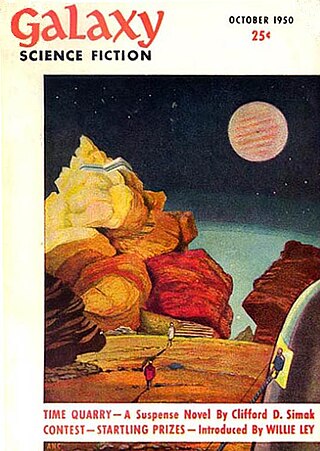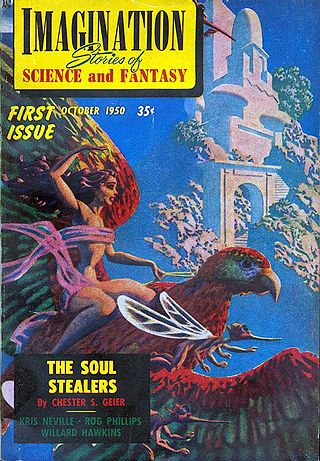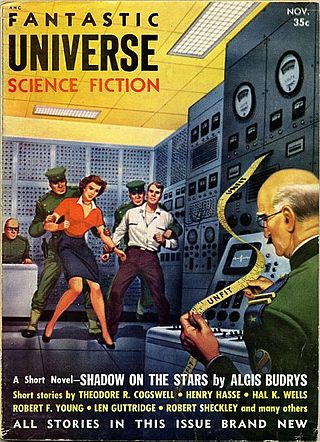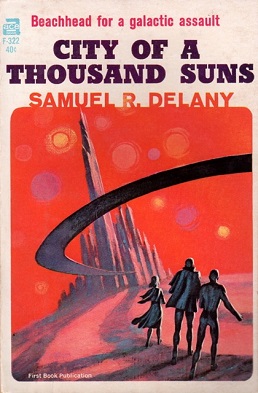
Galaxy Science Fiction was an American digest-size science fiction magazine, published in Boston from 1950 to 1980. It was founded by a French-Italian company, World Editions, which was looking to break into the American market. World Editions hired as editor H. L. Gold, who rapidly made Galaxy the leading science fiction magazine of its time, focusing on stories about social issues rather than technology.

The Encyclopedia of Science Fiction (SFE) is an English language reference work on science fiction, first published in 1979. It has won the Hugo, Locus and British SF Awards. Two print editions appeared in 1979 and 1993. A third, continuously revised, edition was published online from 2011; a change of web host was announced as the launch of a fourth edition in 2021.
Encyclopedia of Science Fiction or Science Fiction Encyclopedia may refer to:

John Frederick Clute is a Canadian-born author and critic specializing in science fiction and fantasy literature who has lived in both England and the United States since 1969. He has been described as "an integral part of science fiction's history" and "perhaps the foremost reader-critic of science fiction in our time, and one of the best the genre has ever known." He was one of eight people who founded the English magazine Interzone in 1982.
David Pringle is a Scottish science fiction editor and critic.
Science Fiction Studies (SFS) is an academic journal founded in 1973 by R. D. Mullen. The journal is published three times per year at DePauw University. As the name implies, the journal publishes articles and book reviews on science fiction, but also occasionally on fantasy and horror when the topic also covers some aspect of science fiction as well. Known as one of the major academic publications of its type, Science Fiction Studies is considered the most "theoretical" of the academic journals that publish on science fiction.

Infinity Science Fiction was an American science fiction magazine, edited by Larry T. Shaw, and published by Royal Publications. The first issue, which appeared in November 1955, included Arthur C. Clarke's "The Star", a story about a planet destroyed by a nova that turns out to have been the Star of Bethlehem; it won the Hugo Award for that year. Shaw obtained stories from some of the leading writers of the day, including Brian Aldiss, Isaac Asimov, and Robert Sheckley, but the material was of variable quality. In 1958 Irwin Stein, the owner of Royal Publications, decided to shut down Infinity; the last issue was dated November 1958.

Imagination was an American fantasy and science fiction magazine first published in October 1950 by Raymond Palmer's Clark Publishing Company. The magazine was sold almost immediately to Greenleaf Publishing Company, owned by William Hamling, who published and edited it from the third issue, February 1951, for the rest of the magazine's life. Hamling launched a sister magazine, Imaginative Tales, in 1954; both ceased publication at the end of 1958 in the aftermath of major changes in US magazine distribution due to the liquidation of American News Company.
Brian Ash was a British writer, scientific journalist, and editor. Ash was best known for his bibliographies and reference books. In the 1970s he wrote several works on science fiction, including Faces of the Future, Who's Who in Science Fiction, and Who's Who in H. G. Wells. He also was the editor of The Visual Encyclopedia of Science Fiction, which contained chapter introductions from science fiction authors as well as articles on the themes of science fiction written by himself and others. The latter title was, in 1978, listed as one of the ALA Best Books for Young Adults. He was married once, and had two children.

Beyond Fantasy Fiction was a US fantasy fiction magazine edited by H. L. Gold, with only ten issues published from 1953 to 1955. The last two issues carried the cover title of Beyond Fiction, but the publication's name for copyright purposes remained as before.

Fantastic Universe was a U.S. science fiction magazine which began publishing in the 1950s. It ran for 69 issues, from June 1953 to March 1960, under two different publishers. It was part of the explosion of science fiction magazine publishing in the 1950s in the United States, and was moderately successful, outlasting almost all of its competitors. The main editors were Leo Margulies (1954–1956) and Hans Stefan Santesson (1956–1960).

City of a Thousand Suns is a 1965 science fantasy novel by American writer Samuel R. Delany, the final novel in the Fall of the Towers trilogy.

The Book of Ptath is a science fiction novel by Canadian-American writer A. E. van Vogt. It was first published in book form in 1947 by Fantasy Press in an edition of 3,021 copies. The novel was originally serialized in the magazine Unknown in October 1943. The book has also appeared under the titles Two Hundred Million A.D. and Ptath.
Shasta Publishers was a science fiction and fantasy small press specialty publishing house founded in 1947 by Erle Melvin Korshak, T. E. Dikty, and Mark Reinsberg, who were all science fiction fans from the Chicago area. The name of the press was suggested by Reinsberg in remembrance of a summer job that he and Korshak had held at Mount Shasta.

Stanley Mullen was an American artist, short story writer, novelist and publisher. He studied writing at the University of Colorado at Boulder and drawing, painting and lithography at the Colorado Springs Fine Arts Center where he was accepted as a professional member in 1937. A series of his paintings of Indian ceremonial dances is part of the permanent collection of the Denver Art Museum. Mullen worked as assistant curator of the Colorado State Historical Museum during the 1940s.

Kinsmen of the Dragon is a fantasy novel by author Stanley Mullen. It was published in 1951 by Shasta Publishers in an edition of 3,500 copies. The book had originally been announced by Mullen's own Gorgon Press. The jacket art was by Hannes Bok.
William Levi Crawford was an American publisher and editor.

Garan the Eternal is a collection of science fiction short fiction by American writer Andre Norton. It was first published in a hardcover edition of 1,300 copies by Fantasy Publishing Company, Inc. in December 1972. The first paperback edition was issued by DAW Books in March 1973, and was reprinted in July 1975, December 1978, June 1985, and September 1987.]
Marshall Benton Tymn was an editor, academic and bibliographer of science fiction and fantasy. He received the Pilgrim Award in 1990. He was a founder of the Instructors of Science Fiction in Higher Education.

Encyclopedia of Science Fiction is a 1978 book of essays about the science fiction genre, largely as a literary form but also covering cinema, TV and illustration.












